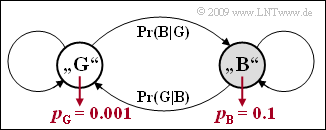Aufgabe 5.6Z: GE-Modelleigenschaften
Wir betrachten das Bündelfehler–Kanalmodell nach E.N. Gilbert und E.O. Elliott (siehe Skizze). Für die Übergangswahrscheinlichkeiten soll dabei gelten:
- $${\rm Pr}(\rm G\hspace{0.05cm}|\hspace{0.05cm} B)= 0.1, \hspace{0.2cm} {\rm Pr}(\rm B\hspace{0.05cm}|\hspace{0.05cm} G) = 0.01\hspace{0.05cm}.$$
Die Fehlerwahrscheinlichkeit im Zustand „GOOD” betrage $p_{\rm G} = 0.1\%$ und für die im Zustand „BAD” gelte $p_{\rm B} = 10\%$.
Im Verlaufe dieser Aufgabe sollen weitere Kenngrößen ermittelt werden:
- die mittlere Fehlerwahrscheinlichkeit $p_{\rm M}$,
- die Zustandswahrscheinlichkeiten $w_{\rm G} = \rm Pr(Z = G)$ und $w_{\rm B} = \rm Pr(Z = B)$,
- die Werte der Korrelationsfunktion, die für $k > 0$ analytisch wie folgt gegeben ist:
- $$\varphi_{e}(k) = p_{\rm M}^2 + (p_{\rm B} - p_{\rm M}) \cdot (p_{\rm M} - p_{\rm G}) \cdot [1 - {\rm Pr}(\rm B\hspace{0.05cm}|\hspace{0.05cm} G )- {\rm Pr}(\rm G\hspace{0.05cm}|\hspace{0.05cm} B )]^{\it k} \hspace{0.05cm}.$$
Hinweise:
- Die Aufgabe gehört zum Kapitel Bündelfehlerkanäle.
- Bezug genommen wird aber auch auf das Kapitel Markovketten im Buch „Stochastische Signaltheorie”. und insbesondere auf die Seite Fehlerkorrelationsfunktion des GE–Modells im Buch „Kanalcodierung”.
Fragebogen
Musterlösung
(2) Das GE–Modell ist eine stationäre Markovkette. Für die Wahrscheinlichkeit, dass sich diese im Zustand „GOOD” befindet, gilt unter Berücksichtigung des Ergebnisses der Teilaufgabe (1):
- $$w_{\rm G} = {\rm Pr}(\rm G\hspace{0.05cm}|\hspace{0.05cm} G) \cdot w_{\rm G} + {\rm Pr}(\rm G\hspace{0.05cm}|\hspace{0.05cm} B) \cdot w_{\rm B}\hspace{0.3cm} \Rightarrow \hspace{0.3cm} {\rm Pr}(\rm B\hspace{0.05cm}|\hspace{0.05cm} G) \cdot w_{\rm G} = {\rm Pr}(\rm G\hspace{0.05cm}|\hspace{0.05cm} B) \cdot w_{\rm B} \hspace{0.05cm}.$$
Weiter gilt $w_{\rm B} = 1 \, –w_{\rm G}$:
- $${\rm Pr}(\rm B\hspace{0.05cm}|\hspace{0.05cm} G) \cdot w_{\rm G} + {\rm Pr}(\rm G\hspace{0.05cm}|\hspace{0.05cm} B) \cdot w_{\rm G} = {\rm Pr}(\rm G\hspace{0.05cm}|\hspace{0.05cm} B)$$
- $$\Rightarrow \hspace{0.3cm} w_{\rm G} = \frac{{\rm Pr}(\rm G\hspace{0.05cm}|\hspace{0.05cm} B)}{{\rm Pr}(\rm G\hspace{0.05cm}|\hspace{0.05cm} B) + {\rm Pr}(\rm B\hspace{0.05cm}|\hspace{0.05cm} G)} = \frac{0.1}{0.1 + 0.01} \hspace{0.15cm}\underline {\approx 0.909} \hspace{0.05cm},\hspace{0.2cm} w_{\rm B} = 1 - w_{\rm G }\hspace{0.15cm}\underline {\approx 0.091}\hspace{0.05cm}.$$
(3) Die mittlere Fehlerwahrscheinlichkeit $p_{\rm M}$ ergibt sich aus den Fehlerwahrscheinlichkeiten $p_{\rm G}$ und $p_{\rm B}$, gewichtet mit $w_{\rm G}$ und $w_{\rm B}$:
- $$p_{\rm M} = w_{\rm G} \cdot p_{\rm G} + w_{\rm B} \cdot p_{\rm B} = \frac{10}{11} \cdot 10^{-3} + \frac{1}{11} \cdot 10^{-1}= \frac{10+100}{11} \cdot 10^{-3}\hspace{0.15cm}\underline { = 0.01}\hspace{0.05cm}.$$
(4) Entsprechend der allgemeinen Gleichung auf dem Angabenblatt gilt für $k > 0$:
- $$\varphi_{e}(k) \hspace{-0.1cm} \ = \ \hspace{-0.1cm} p_{\rm M}^2 + (p_{\rm B} - p_{\rm M}) \cdot (p_{\rm M} - p_{\rm G}) \cdot [1 - {\rm Pr}(\rm B\hspace{0.05cm}|\hspace{0.05cm} G )- {\rm Pr}(\rm G\hspace{0.05cm}|\hspace{0.05cm} B )]^{\it k} = 10^{-4} + 0.09 \cdot 0.009 \cdot 0.89^{\it k} = 10^{-4} \cdot \left ( 1 + 8.1 \cdot 0.89^{\it k} \right )\hspace{0.05cm}.$$
- $$\Rightarrow \hspace{0.3cm}\varphi_{e}(k = 1 ) \hspace{-0.1cm} \ = \ \hspace{-0.1cm} 10^{-4} \cdot \left ( 1 + 8.1 \cdot 0.89^{ 1} \right ) \hspace{0.15cm}\underline {= 8.209 \cdot 10^{-4}} \hspace{0.05cm},$$
- $$\Rightarrow \hspace{0.3cm}\varphi_{e}(k = 2 ) \hspace{-0.1cm} \ = \ \hspace{-0.1cm} 10^{-4} \cdot \left ( 1 + 8.1 \cdot 0.89^{ 2} \right )\hspace{0.15cm}\underline { = 7.416 \cdot 10^{-4}} \hspace{0.05cm},$$
- $$\Rightarrow \hspace{0.3cm}\varphi_{e}(k = 5 ) \hspace{-0.1cm} \ = \ \hspace{-0.1cm} 10^{-4} \cdot \left ( 1 + 8.1 \cdot 0.89^{ 5} \right )\hspace{0.15cm}\underline {= 5.523 \cdot 10^{-4}} \hspace{0.05cm},$$
- $$\Rightarrow \hspace{0.3cm}\varphi_{e}(k = 50 ) \hspace{-0.1cm} \ = \ \hspace{-0.1cm} 10^{-4} \cdot \left ( 1 + 8.1 \cdot 0.89^{ 50} \right ) \hspace{0.15cm}\underline {= 1.024 \cdot 10^{-4}} \hspace{0.05cm}.$$
(5) Für jedes Kanalmodell gilt wegen $e_{\nu} ∈ \{0, 1\}$:
- $$\varphi_{e}(k = 0 ) = {\rm E}[e_{\nu} ^2] = {\rm E}[e_{\nu} ] = p_{\rm M} \hspace{0.05cm}.$$
Mit dem Ergebnis der Teilaufgabe (3) ergibt sich für den vorliegenden Fall $\varphi_e(k = 0) \ \underline {= 0.01}$.
(6) Entsprechend der Teilaufgabe (3) gilt
- $$p_{\rm M} = {10}/{11} \cdot p_{\rm G} + {1}/{11} \cdot p_{\rm B} \hspace{0.05cm}.$$
Bei vorgegebenem $p_{\rm B} = 0.1$ ergibt sich selbst für $p_{\rm G} = 0$ (kein Fehler im Zustand „G”) die mittlere Fehlerwahrscheinlichkeit zu $p_{\rm M} \approx 0.009$. Dagegen ist mit festem $p_{\rm G} = 0.001$ der Wert $p_{\rm M} = 0.005$ erreichbar:
- $$0.005 = {10}/{11} \cdot 10^{-3} + {1}/{11} \cdot p_{\rm B} \hspace{0.3cm} \Rightarrow \hspace{0.3cm} p_{\rm B} \le 0.055 - 0.1 = 4.5\%\hspace{0.05cm}.$$
Weiterhin kann die mittlere Fehlerwahrscheinlichkeit (mit vorgegebenem $p_{\rm G}$ und $p_{\rm B}$) auch wie folgt dargestellt werden:
- $$p_{\rm M} = \frac{p_{\rm G} \cdot {\rm Pr}(\rm G\hspace{0.05cm}|\hspace{0.05cm} B)+ p_{\rm B} \cdot {\rm Pr}(\rm B\hspace{0.05cm}|\hspace{0.05cm} G)}{{\rm Pr}(\rm G\hspace{0.05cm}|\hspace{0.05cm} B) + {\rm Pr}(\rm B\hspace{0.05cm}|\hspace{0.05cm} G)} = \frac{0.001 \cdot {\rm Pr}(\rm G\hspace{0.05cm}|\hspace{0.05cm} B)+ 0.1 \cdot {\rm Pr}(\rm B\hspace{0.05cm}|\hspace{0.05cm} G)}{{\rm Pr}(\rm G\hspace{0.05cm}|\hspace{0.05cm} B) + {\rm Pr}(\rm B\hspace{0.05cm}|\hspace{0.05cm} G)}\hspace{0.05cm}.$$
Mit $\rm Pr(B|G) = 0.01$ bzw. mit $\rm Pr(G|B) = 0.1$ erhält man folgende Gleichungen:
- $${\rm Pr}(\rm B\hspace{0.05cm}|\hspace{0.05cm} G) = 0.01\hspace{-0.15cm}:\hspace{0.2cm} {\it p}_{\rm M} \hspace{-0.1cm} \ = \ \hspace{-0.1cm} \frac{0.001 \cdot {\rm Pr}(\rm G\hspace{0.05cm}|\hspace{0.05cm} B)+ 0.001 }{{\rm Pr}(\rm G\hspace{0.05cm}|\hspace{0.05cm} B) + 0.01}\hspace{0.05cm},\hspace{0.5cm} {\rm Pr}(\rm G\hspace{0.05cm}|\hspace{0.05cm} B) = 0.1\hspace{-0.15cm}:\hspace{0.2cm}{\it p}_{\rm M} \hspace{-0.1cm} \ = \ \hspace{-0.1cm} \frac{0.0001 + 0.1 \cdot {\rm Pr}(\rm B\hspace{0.05cm}|\hspace{0.05cm} G)}{0.1 +{\rm Pr}(\rm G\hspace{0.05cm}|\hspace{0.05cm} B) }\hspace{0.05cm}.$$
Aus der oberen Gleichung ist zu erkennen, dass mit keinem $\rm Pr(G|B)$–Wert das Ergebnis $p_{\rm M} = 0.005$ möglich ist. Dagegen lässt sich durch ein kleineres $\rm Pr(B|G)$ die Bedingung erfüllen:
- $$0.005 = \frac{0.0001 + 0.1 \cdot {\rm Pr}(\rm B\hspace{0.05cm}|\hspace{0.05cm} G)}{0.1 +{\rm Pr}(\rm B\hspace{0.05cm}|\hspace{0.05cm} G) } \hspace{0.3cm} \Rightarrow \hspace{0.3cm}{\rm Pr}(\rm B\hspace{0.05cm}|\hspace{0.05cm} G) \le \frac{0.0004}{0.095} \approx 0.0042\hspace{0.05cm}.$$
Richtig sind somit die Lösungsvorschläge 2 und 4.
